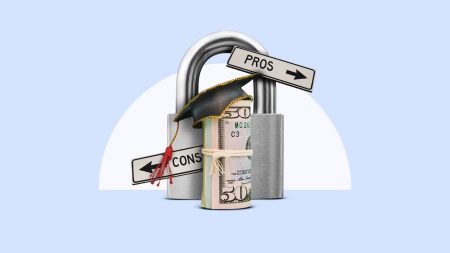Key takeaways
- CDs earning 4% APY provide guaranteed returns with FDIC insurance up to $250,000 — making them one of the safest investments available.
- A $10,000 CD at 4% APY earns $400 in one year, while a 5-year CD at 4% APY generates $2,166 in total interest.
- CD laddering spreads investments across multiple terms, giving you regular access to maturing funds while capturing today’s high rates.
-
Lock in current 4%+ rates now before the Federal Reserve’s rate cuts push yields lower — waiting could cost you hundreds in lost interest.
CD investing involves depositing money into certificates of deposit that earn fixed interest rates for set periods—typically 3 months to 5 years. Your principal remains locked until maturity, but you earn guaranteed returns significantly higher than traditional savings accounts.
Top 1-year CDs currently pay over 4.00% APY compared to the national average of 1.95% APY — nearly 4x more interest on your money.
Unlike stocks or bonds, CDs offer zero market risk. Your return is guaranteed from day one, and FDIC insurance protects deposits up to $250,000 per account. This makes CDs ideal for conservative investors, retirees seeking steady income or anyone saving for near-term goals where you can’t afford stock market volatility.
Despite recent Federal Reserve rate cuts, you can still find CDs outpacing the inflation rate. However, rates are declining — locking in today’s 4% yields before further cuts makes financial sense.
Are CDs a good way to invest?
Yes, if you prioritize safety over growth. CDs work best for:
- Short-term goals (1-5 years): Down payment funds, wedding expenses, or planned purchases where you need guaranteed principal and can’t risk market losses.
- Emergency fund surplus: Once you have 3-6 months of expenses in a high-yield savings account, parking additional emergency reserves in short-term CDs (6-12 months) earns more while maintaining relatively quick access.
- Risk-averse portfolios: Retirees or conservative investors who can’t stomach stock volatility but want better returns than savings accounts.
- Rate-locking strategy: When CD rates are high (like now) but expected to fall, locking in multi-year terms preserves higher returns.
When CDs don’t make sense:
- Long-term growth (10+ years): Stocks historically outperform CDs significantly
- Need frequent access to money: Early withdrawal penalties wipe out interest gains
- Chasing maximum returns: Stock market averages 10% annually vs. 4-5% for CDs
CDs aren’t “investments” in the traditional sense — they’re savings vehicles. If your primary goal is wealth building over decades, stocks and index funds will serve you better. But for safe, guaranteed returns on money you’ll need in 1-5 years, CDs are hard to beat.
Expert insight: When CDs make sense
“With the Fed cutting rates in the back half of 2025, now might be an opportune time to lock in today’s higher CD rates, especially for longer terms. CDs work best for money you absolutely cannot afford to lose — think down payment funds or college tuition due in 2-3 years. For longer-term goals, you’re leaving growth on the table compared to diversified stock portfolios.”
— Hanna Horvath, CFP & Bankrate Banking Editor
How much can you earn with CDs?
Your CD earnings depend on four factors: deposit amount, interest rate, term length and compounding frequency. Let’s assume you’re investing at 4% APY:
| Amount | CD term | Total interest | Final value |
| $10,0000 | 1 year | $400 | $10,400 |
| $10,000 | 3 years | $1,248.64 | $11,248.64 |
| $10,000 | 5 years | $2,166.53 | $12,166.53 |
| $20,000 | 1 year | $800 | $20,800 |
| $20,000 | 5 years | $4,333.06 | $24,333.06 |
| $50,000 | 5 years | $10,832.65 | $60,832.65 |
With inflation at 2.7%, a CD earning 4.00% APY provides a real return of 1.3% annually.
Calculate your exact CD returns Use Bankrate’s CD calculator to project earnings for any amount and term →
How to start investing in CDs (6 steps)
1. Determine your investment goals and timeline
Ask yourself: When will I need this money? CDs work best when you have a specific target date.
- Down payment in 3 years? Consider a 3-year CD or ladder
- Emergency fund you might need? Stick to 6-12 month terms
- Retirement income 2 years out? Longer terms lock in today’s rates
2. Compare the best CD rates
Shop around — rates vary dramatically between institutions. Online banks typically offer 0.5-1.0% higher APYs than traditional brick-and-mortar banks. Current top rates:
3. Choose your CD term
Match the term to when you’ll need the money. Don’t lock into a 5-year CD if you might need funds in 2 years — early withdrawal penalties typically equal 3-12 months of interest.
4. Decide your deposit amount
Minimum deposits vary:
- Many online banks: $0-$500 minimum
- Traditional banks: $1,000-$2,500 minimum
- Jumbo CDs: $25,000-$100,000 minimum (slightly higher rates)
Only invest money you can leave untouched. If there’s any chance you’ll need it, use a no-penalty CD or high-yield savings account instead.
5. Consider a CD strategy
Don’t put all your money in one CD. Strategies like laddering provide better flexibility and potentially higher returns.
6. Open your CD and fund it
Most online banks let you open CDs in 5-10 minutes. You’ll need:
- Government-issued ID
- Social Security number
- Funding source (bank account transfer)
Once opened, your rate is locked for the entire term. You’ll typically receive interest monthly or at maturity, depending on the CD type.
CD investing strategies
The smartest CD investors use multiple CDs with different terms to optimize returns and maintain flexibility.
CD laddering
A CD ladder staggers maturity dates so you have regular access to funds while capturing higher long-term rates.
Example $10,000 ladder:
- $2,000 in 1-year CD at 4.00% APY
- $2,000 in 2-year CD at 4.15% APY
- $2,000 in 3-year CD at 4.30% APY
- $2,000 in 4-year CD at 4.35% APY
- $2,000 in 5-year CD at 4.40% APY
How it works: When the 1-year CD matures, reinvest it in a new 5-year CD at current rates. Do the same with each CD as it matures. Within 4 years, all your money is earning the highest 5-year rates, but you have access to 20% of your funds annually.
Barbell strategy
Splits money between short-term and long-term CDs, skipping mid-range terms.
Example $10,000 barbell:
- $5,000 in 6-month CD at 4.20% APY
- $5,000 in 5-year CD at 4.40% APY
How it works: Short-term CD gives flexibility to reinvest in 6 months if rates rise. Long-term CD locks in today’s high rates in case rates fall. When the 6-month CD matures, reassess: if rates are higher, open another short-term CD. If rates dropped, extend to longer term.
Bullet strategy
All CDs mature at the same target date— perfect for specific goals.
How it works: Spread investments over time instead of lump sum upfront. Captures rate changes along the way while all funds mature when needed.
Types of CDs to consider
Not all CDs are traditional “deposit money, wait until maturity” accounts. Consider these alternatives:
Bump-up CD
A bump-up CD gives you the option to request a rate increase a certain number of times during the term. So, let’s say you open a 2-year CD with a 4.00% APY, and eight months later, the rate is 4.50% APY. You can ask for the increase. Typically, these CDs only allow for one increase per term and they generally make the most sense when rates are expected to rise.
Step-up CD
A step-up CD is similar to a bump-up CD except the bank does the work for you. You’ll have an idea of the rate increases before you open. For example, a bank’s 28-month CD might start with a 4.00 percent APY and increase by 0.25 percent every seven months.
No-penalty CD
With a no-penalty CD, the name says it all. You don’t have to worry about handing over any earnings if you make a withdrawal before the maturity date – and generally at least seven days after making your deposit. These typically offer slightly lower rates than traditional CDs but provide much more flexibility.
Check out the best no-penalty CD rates.
Add-on CD
Add-on CDs function more like a standard savings account. After you open the CD, you can make additional deposits to the principal. Some add-on CDs allow for unlimited additional deposits, but others may have limits on how many contributions can be made. The downside is that they may earn less than standard CDs.
Callable CD
Callable CDs put more power in the bank’s hands to call – close out – your CD. For example, let’s say your CD is paying a 4.5 percent APY. If interest rates drop and the bank doesn’t want to pay that much interest, it can call (close) your CD. These typically offer higher rates to compensate for this risk, but should be approached with caution.
Jumbo CD
Jumbo CDs typically require a minimum deposit of $100,000, though some institutions set the threshold at $50,000 or $25,000. They may offer slightly higher rates than standard CDs to reward the larger deposit, though this isn’t always the case.
See the best jumbo CD rates.
How CD investing compares to alternatives
CDs vs. high-yield savings accounts
Choose CDs if: You want to lock in guaranteed rates before they drop and won’t need the money for months or years. With the Federal Reserve cutting rates, today’s CD rates could look attractive compared to variable savings account rates in 6-12 months. CDs currently offer around 4.00% APY with rate protection for the full term — what you see is what you get. The trade-off? Your money is locked up until maturity, and early withdrawals trigger penalties of 3-12 months of interest.
Choose high-yield savings if: You need flexibility to access your money or think rates might rise. High-yield savings accounts currently offer around 4.00% APY — sometimes higher than CDs — with zero withdrawal penalties and same-day access to funds. Rates are variable, meaning they can drop anytime (and likely will as the Fed continues cutting), but you’re never locked in. They’re best for emergency funds or money you might need within the next few months.
CDs vs. money market accounts
The difference: Money market accounts function like hybrid checking-savings accounts with high rates, while CDs are pure savings vehicles with locked terms. Money market accounts offer around 4.00% APY with check-writing privileges, debit cards and ATM access — making them practical for bills or expenses while earning strong interest. You get the flexibility of a checking account with higher rates. The catch? Many money market accounts have high minimum balance requirements (typically $2,500-$10,000) and variable rates that can drop anytime.
Choose CDs if: You don’t need check-writing features and want guaranteed rates. Your money is completely locked up (which forces discipline), but you know exactly what you’ll earn.
Choose money market accounts if: You want high rates plus payment flexibility — ideal for holding funds you’re actively managing but want earning more than checking accounts. Think: business accounts, rent payments or large planned expenses where you need both yield and access.
CDs vs. Treasury bills (T-Bills)
The tax advantage: Treasury Bills offer one significant edge over CDs — interest is exempt from state and local income taxes (but not federal). T-Bills currently yield high APYs for terms of 4, 8, 13, 26, and 52 weeks, issued by the U.S. Treasury with zero default risk — arguably even safer than FDIC insurance.
However, CDs are simpler: You can open a CD at your existing bank in 5 minutes versus navigating TreasuryDirect.gov. CDs offer more term flexibility (3 months to 5 years vs. T-Bill’s maximum 52 weeks). And if you need money early, CD penalties are predictable; with T-Bills, you must sell on the secondary market at whatever price buyers offer.
FAQs
Bottom Line
CD investing provides guaranteed, risk-free returns — perfect for short-term goals, emergency fund surpluses, or conservative portfolios. With rates declining as the Federal Reserve continues cuts, locking in today’s yields could save hundreds to thousands in interest over the coming years.
The smartest CD investors don’t put all their money in one term. Strategies like laddering balance higher long-term rates with regular access to maturing funds. Whether you’re saving for a down payment in 3 years or simply want guaranteed returns, CDs deliver safety and predictability that no other investment can match.
Shop around for the best rates — differences of 0.5-1.0% APY mean hundreds of dollars on typical deposit amounts.
Why we ask for feedback
Your feedback helps us improve our content and services. It takes less than a minute to
complete.
Your responses are anonymous and will only be used for improving our website.
Help us improve our content
Read the full article here









